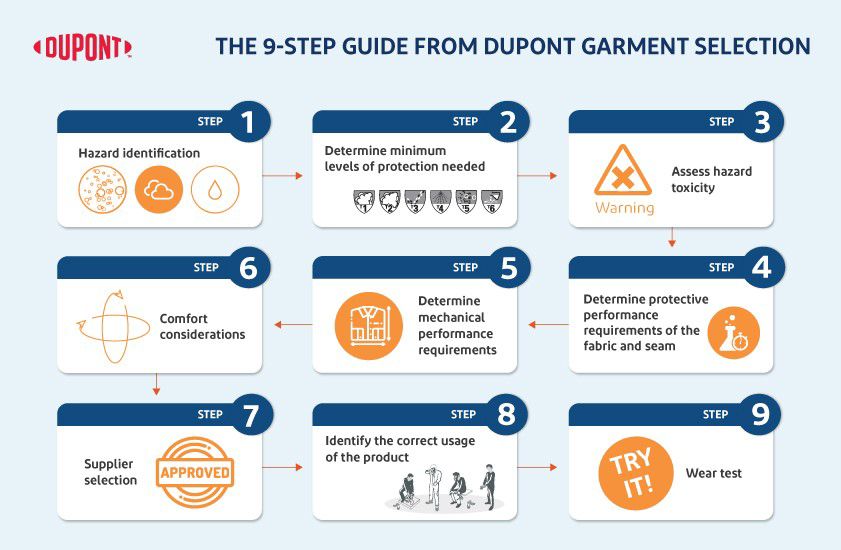How To Choose Appropriate Protective Clothing?

Faced with a vast array of potential hazards, a bewildering choice of protective clothing, and the complexity of the certification information, what criteria should be used to select the proper protective clothing?
This Selection Guide summarises the European Standards for Personal Protective Equipment (PPE) and further information on which to base your decisions. For overall risk analysis, follow the 9 STEPS (in alignment with national legislation/recommendations) to arrive at the most appropriate protective clothing.
- Step 1 - The first step is to conduct a detailed assessment of the working environment(s) concerned and the nature of the hazard(s) that are, or maybe, present.
- Step 2
a. Determine the degree(s) of exposure level(s) to identify a suitable minimum garment ‘CE–Type.’ The 6 CE Category III Types (Type 1 to 6) of chemical protective clothing protection facilitate the selection to determine the nature of the hazard exposure.
b. Certification to a particular protection Type represents the tightness of the garment against a particular form of exposure (gas, liquid, or dust). However, it does not mean that the item is 100% impervious to this type of exposure.
- Step 3
a. To know the toxicity or consequences of shorter long-term exposure to a hazard, consider whether a coverall has been tested to EN ISO 6529, which gives information about the fabric’s chemical permeation and penetration, where the chemical is tested for between 10 to 480 minutes.
b. You can get additional information from the Instructions for Use attached to DuPont products packaging, where you can find permeation data for a selection of chemicals.
- Step 4
a. Fabric –
i. From Tychem® and Tyvek® to SMS and microporous film (MPF) fabrics, DuPont offers a variety of materials with different levels of comfort, durability, breathability, and protection to meet your specific needs.
ii. Knowing how well the fabric used in the garment provides a barrier to specific hazardous materials is crucial. Testing for chemical protective fabrics is divided into two primary categories:
1. Penetration testing - appropriate for particle hazards - Penetration occurs when a material's bulk movement through a pore, hole, gap, or defect in the fabric is the proper method to evaluate particle barrier.
2. Permeation testing - appropriate for liquid and gaseous hazards – A liquid or vapour can permeate through a fabric even when there is no observed opening in the material. This test is critical for garments exposed to hazardous liquids, vapours, or gases.
b. Seam construction - Appropriate seam configuration for your application is critical, and the knowledge that the garment has been constructed with strong, tight seams. One loose thread or gap and the barrier between you and your environment unravels—leaving you vulnerable.
- Step 5
a. To assess the protective clothing from a ‘whole garment’ perspective and determine its mechanical properties, strength, abrasion resistance, susceptibility to tearing, and seam integrity, we recommend you undergo garment wear trials under ‘actual conditions of use.
b. The correct size and cut of a protective coverall significantly impact the wearer’s protection. DuPont protective garments come in various sizes to suit different physical and gender characteristics, are non-restrictive, ergonomically fit, and compatible with other PPE items without being bulky to avoid snagging, tearing, or tripping.
- Step 6
a. Maximising the wearer’s comfort while identifying the appropriate protection and mechanical performance is critical. It will significantly contribute to correct coverall use with optimised wearer satisfaction and productivity.
b. As with protection-in-use (please see Step 5), it is essential to develop and practice donning and doffing procedures (Step 8). Conduct user wear trials to assess the perceived comfort in-use of the garment(s) being considered.
c. DuPont offers various garment styles - from hoods and shoe covers to aprons, coveralls, and fully encapsulated suits.
- Step 7
a. Next, you should ensure that the protective garments are free from hazardous or banned ingredients, do not present hazards to the ecosystem, and do not include skin allergens or sensitisers. It is essential to consider the manufacturer’s reputation, accreditations, the brand's strength, business credentials, ethical standing, and environmental record, in addition to the basic garment requirements.
b. An exceptional manufacturer should provide a high level of pre-and aftersales service and support, ideally including training programs, testing services, selection tools, risk-analysis guidance, and permeation data.
- Step 8 – The wearers should be aware of the product limitations and are appropriately trained for correct donning, doffing, and usage. The product’s manual should be followed carefully for additional protection and care instructions.
- Step 9
a. To evaluate performance, wear trials are essential to ensure full ‘in-use’ compatibility under expected operating conditions.
b. These user try-out exercises should involve as many people as possible, depending on the nature of the work; these trials may be conducted over days or weeks to evaluate if it results in the correct and most cost-efficient choice of protection.
Please contact your DuPont representative or distributor to get a wear-trial form. The result will be a choice of garment that fulfils user expectations in terms of fit, function, comfort, performance, durability, and, of course, safety.
DuPont provides innovative protection solutions and expert technical support tailored to meet the specific needs of workers in the oil & gas industry worldwide. Reach out to us to know how we can help you better protect your workers. #DuPontPPE #Tyvek #Tychem #Kevlar #Nomex #Safety #PPE